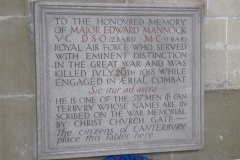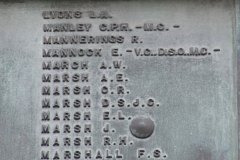Major Edward (‘Mick’) Mannock VC, DSO (2bars), MC (1 bar) was one of the most successful and highest decorated war air aces of World War I. After a record count of 75 service air combats, he was shot down over France behind enemy lines in July 1918 but received a posthumous VC.
Mick’s birthplace and even birth date are, amazingly, uncertain. The place is quoted variously as Brighton, Canterbury, Aldershot and India, and the year as either 1887 or 1888.
Son of Edward Mannock, a corporal in the Royal Scots regiment, Mick’s childhood was spent on the move, including spells in Canterbury, other parts of England, Scotland, Ireland and India. Concrete evidence on his association with Canterbury is hard to pin down. It seems the family moved to Military Road around 1900. Soon after this Mick’s father left the family and never returned – although he did later turn up to collect his son’s postumous VC. Known as Paddy or Eddie (the Mick came later), the boy attended St Thomas’ School and was apparently reticent and shy. He played kettle drum and bugle in the Territorial army band. On leaving school he joined his brother Patrick working in the National Telephone Company.
After WW1 the citizens of Canterbury were keen to honour Mick as a local hero, and fought to have his name included on the city war memorial (see Buttermarket), even though he clearly failed to meet the strict criteria in terms of local birth, local family connections, etc. Local feeling won the day – his memorial appears on the south wall of the nave, and his name appears on the city memorial in the Buttermarket outside the cathedral gates. Dean Bell unveiled the cathedral memorial in July 1925 before an attendance estimated at around 1500 people. This included representatives of the Canterbury Church Lads’ Brigade, of which Mick had been a member before the war.
What to see:
- the cathedral memorial on the south wall of the nave (Image 1)
- the city war memorial in the Buttermarket nearby (Image 2)
Sources: Donaldson (2006); Dudgeon (1981); Franks (2008); Oughton (2004); also Dover Express Friday 24 July 1925; subject is also covered in many World War I web sites.
DL


